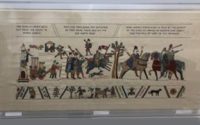What’s on : Activities
Event Information
Visit to the Stamford Bridge Tapestry Project
Wednesday 4th September 2024, 2pm
Cost: £10 per person for a viewing and talk at 2pm, including tea/coffee and cake.
The tapestry commemorates the Battle of Stamford Bridge in 1066 when the Saxons comprehensively defeated the Vikings. It was stitched by local people in the style of the Bayeux tapestry between 2015 and 2021. It is housed in: The Old Station Club, 24 Church Road, Stamford Bridge, York, YO41 1DG.
We will meet at the Old Station Club approximately 1.45 pm for a 2pm start. There is a car park and on-road parking nearby. The number 10 bus from York stops directly outside. We will have a talk from a volunteer about the battle and the background behind the creation of the tapestry, followed by tea/coffee and cake.
Member’s report
We travelled either by bus or private car to Stamford Bridge’s old station. This is now a community space which includes a pub, youth club and meeting space, and houses the tapestry. We were met by volunteers who hosted us for the afternoon.
Firstly, Brian Fulton gave us a talk about the background to the Battle of Stamford Bridge on 25th September 1066. Harold Godwinson was a relatively new English king. The invading Norwegians were led by Harald Hardrada and the English king’s brother Tostig Godwinson. The Norwegians had over 200 boats which landed in Hull and sailed up the Ouse to Riccall. On 20th September they defeated a Northern English army at the Battle of Fulford, taking hostages and supplies from York. Harald Hardrada was waiting for the arrival of the hostages at Stamford Bridge, lightly armed and with few men.
King Harold was in the south of England, anticipating an invasion from France by another contender to the English throne, when he heard of the Norwegian invasion of the North. He and his men marched day and night from London, covering 185 miles in only 4 days. He thus took the Norwegians waiting at Stamford Bridge completely by surprise.
Legend has it that a single Viking managed to hold off the English army for quite some time, until he was skewered from an English boat underneath the bridge on which he was standing. This event is depicted in the tapestry.
Of the over 200 boats that invaded, only 24 remained to take the surviving Norwegians home. The Victorious Anglo-Saxons had to endure another forced march down to Hastings in October 1066 and so were exhausted. If it were not for the Battle of Stamford Bridge, the result of the Battle of Hastings may have been different.
Another volunteer, Ann Chatten, then gave us a talk about the inspiration behind the tapestry and its creation. Two local men founded the Battle of Stamford Bridge Heritage Society in 2012 and had the idea of telling the story of the battle in the style of the Bayeux tapestry. Work started in September 2015 but Tom Wyles, one of the founders, died shortly afterwards. The other, Chris Rock, was the graphic designer of the tapestry images. He included quirky details such as a person wearing glasses and another holding a mobile phone.
The stitching was carried out by a group of local ladies who met weekly. They used Bayeux stitch which leaves very little wool on the back of the work as wool was very expensive when the Bayeux tapestry was stitched. Eight colours of wool were used, all dyed using natural plant dyes. The linen twill on which it is stitched cost £100 per metre. The tapestry was completed in June 2021 and is housed behind the same perspex as is used in police riot shields. This is just as well as the room is used as a youth club!
We completed our visit with time to view the tapestry at our leisure and enjoy tea/coffee and delicious cakes. Many thanks to Brian and Ann, the speakers, and the other volunteers who manned the kitchen.
Rosemary Anderton

